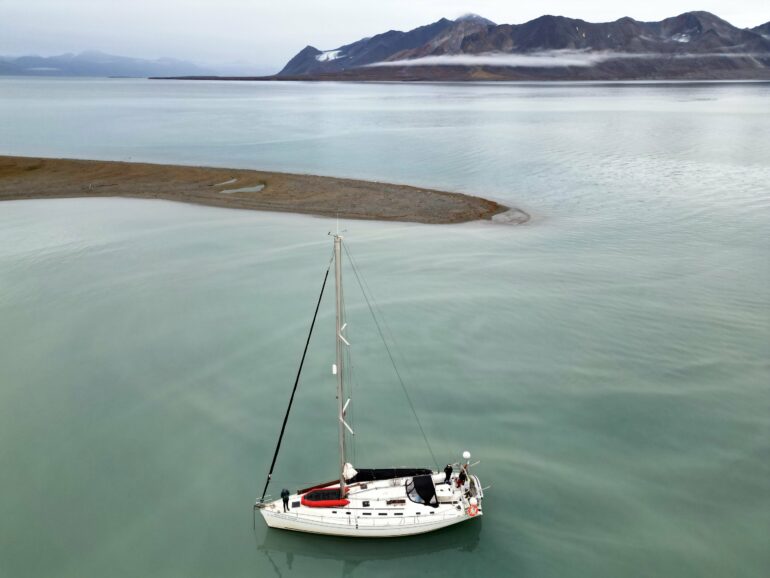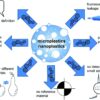Willem van der Bilt from the Department of Earth Science at the University in Bergen and the Bjerknes Center has, together with a group co-led by Mateusz Strzelecki at the University of Wrocław in Poland, worked on various new methods that extract more societally relevant information about hazards from geological archives such as lake sediments. They combined different high-resolution scanning techniques in a geostatistical framework.
In their article published in Nature Communications, they evaluated sediments from a coastal lake on Svalbard. The work is on storminess—wind- and wave-blown particles like sand grains and sea salt that can end up in coastal lakes, recording changes in wind strength and wave height through time.
“We used a toolbox of techniques that are typically applied to extract other past information from geological records. We use them, for example, to learn more about the behavior of glaciers in the past or say something about the frequency of floods. And then I thought; we might as well look at the wind, right?” van der Bilt says.
Van der Bilt takes us through some of the background. The recent rapid decrease in Arctic sea-ice cover has allowed winds to whip up the sea for longer periods and over greater areas. As a result, wave height has increased over the past decades, leading to increased coastal erosion as a lot of energy is transferred to the shoreline when these waves hit Arctic shores.
At the same time, these environments are more sensitive to this battering by waves, as permafrost—the icy glue that holds Arctic coastal landscapes together—thaws in response to climate change. This is a problem not only because the storm-driven collapse of Arctic shores destroys infrastructure, but also because erosion releases vast amounts of carbon from coastal permafrost deposits.
“Now, there are not a lot of people living in the area, but there is a lot of carbon storage in the permafrost of arctic coastlines. It is a huge reservoir of carbon that is being mobilized. And because of this, researchers have become a little bit more interested in the changing behavior of winds and waves in the Arctic. Also, here in Norway.”
The study targeted a coastal lake on Svalbard that they knew could record a stable wind signal through time. They ended up coring a couple of lakes that were protected by a rocky ridge and started looking at these sediments. They used a tested method toolbox, refined it, and also implemented some improvements.
“We got this storm signal out of these sediments. And we started to understand that we could tie different signals that we recorded in these sediments to both wind systems that prevail in the area—the Westerlies and Easterlies, and get 10,000 years of wind history,” van der Bilt says.
They started to look at the result and it is here that the plot thickens. Because the results were the opposite of what the team thought they would be.
“The assumption is that a less icy, warm arctic will be windier, but the sediments show us that it is the other way around. We learned that the stormy phases that we see in our record actually overlap with phases of colder climate conditions in the North Atlantic Ocean. That was a big surprise,” says van der Bilt.
Another thing they observed was a form of cyclicity. “We find that storminess exhibits a 1,500-year cyclicity. This periodicity is a widespread feature of many North Atlantic climate records and acts like a bit of a heartbeat of the region’s climate system.
“Finally, we find that both of the region’s main wind systems—the Polar Easterlies and the Westerlies mimic each other: They weaken and strengthen in synchrony through time,” says van der Bilt.
He believes that this is a research topic has been overlooked and hopes that their study enhances the understanding of a process that shapes our lives and the Earth’s surface—wind. The goal is to boost the emerging field of paleotempestology—the investigation of past wind changes in strength.
Ph.D. student Zofia Stachowska from the Institute of Marine and Environmental Sciences and the Doctoral School at the University of Szczecin is first author on this study. She is extremely happy with the outcome of this research and the publication.
“I am pleased not only because it helps fill significant knowledge gaps, but also because it challenges some widely accepted assumptions about climate change. I think that this surprising pattern we show—such as colder periods being stormier—might be of high relevance. After all, this brings a twist to the narrative that a warmer Arctic will be stormier,” says Stachowska.
She hopes that this publication contributes to the discussion on the relevance of climate models and becomes a reference in paleotempestology, and that the methodology they used perhaps will become the future standard for similar studies.
“I am also excited about the opportunity to apply novel techniques, like high-resolution CT and XRF scanning, which revealed details that would have been invisible to the naked eye. The results we obtained were clear, and this would not have been possible without the multi-proxy approach we employed. I owe a great appreciation to Willem van der Bilt, who supervised my work during my study visits to EARTHLAB at UiB,” she says.
Stachowska hopes to see that what they think of this study proves to be relevant.
“That is—it has real-world implications, and reaches beyond scientific curiosity, as the socio-economic impacts of climate change affect all of us. Svalbard is a climate-change hotspot 2, warming at rates far exceeding the global average, fast-forwarding into the future. Our findings highlight processes that could directly affect the future coastal stability or carbon release from coastal erosion in the Arctic.”
Supervisors van der Bilt and Strzelecki are also excited about the publication.
“It is exciting to be part of, and I really hope that this will come into the picture as a research topic of its own, because I think there’s a lot to discover.”
More information:
Zofia Stachowska et al, Coastal lake sediments from Arctic Svalbard suggest colder summers are stormier, Nature Communications (2024). DOI: 10.1038/s41467-024-53875-1
Provided by
Bjerknes Centre for Climate Research
Citation:
Arctic lake sediment records reveal unexpected storm patterns (2024, November 11)



